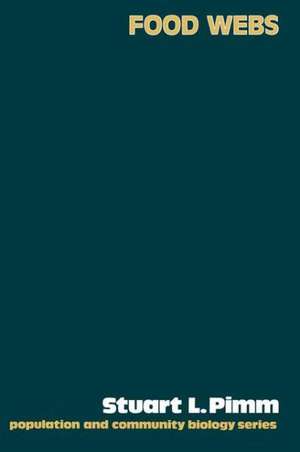Food Webs: Population and Community Biology
Autor S. Pimmen Limba Engleză Paperback – 15 noi 2011
Preț: 384.70 lei
Nou
Puncte Express: 577
Preț estimativ în valută:
73.61€ • 77.06$ • 60.91£
73.61€ • 77.06$ • 60.91£
Carte tipărită la comandă
Livrare economică 05-19 aprilie
Preluare comenzi: 021 569.72.76
Specificații
ISBN-13: 9789400959279
ISBN-10: 9400959273
Pagini: 236
Ilustrații: XII, 220 p.
Dimensiuni: 155 x 235 x 12 mm
Greutate: 0.34 kg
Ediția:Softcover reprint of the original 1st ed. 1982
Editura: SPRINGER NETHERLANDS
Colecția Springer
Seria Population and Community Biology
Locul publicării:Dordrecht, Netherlands
ISBN-10: 9400959273
Pagini: 236
Ilustrații: XII, 220 p.
Dimensiuni: 155 x 235 x 12 mm
Greutate: 0.34 kg
Ediția:Softcover reprint of the original 1st ed. 1982
Editura: SPRINGER NETHERLANDS
Colecția Springer
Seria Population and Community Biology
Locul publicării:Dordrecht, Netherlands
Public țintă
ResearchCuprins
1 Food webs.- 1.1 What and why?.- 1.2 Where?.- 1.3 How?.- 2 Models and their local stability.- 2.1 Introduction.- 2.2 Models.- 2.3 Stability.- 2.4 Summary.- Appendix 2A: Taylor’s expansion.- Appendix 2B: An example of calculating eigenvalues.- Appendix 2C: Jacobian matrices.- 3 Stability: other definitions.- 3.1 Introduction.- 3.2 Global stability.- 3.3 Species deletion stability.- 3.4 Stability in stochastic environments.- 3.5 Other stability criteria.- 3.6 Summary: models and their stabilities — Is there a best buy?.- 4 Food web complexity I: theoretical results.- 4.1 Introduction.- 4.2 Bounds on food web complexity: local stability.- 4.3 Complexity and stability under large perturbations.- 4.4 Summary of theoretical results.- 5 Food web complexity II: empirical results.- 5.1 Direct tests.- 5.2 Indirect tests.- 5.3 Summary.- 6 The length of food chains.- 6.1 Introduction.- 6.2 Hypothesis A: Energy flow.- 6.3 Hypothesis B: Size and other design constraints.- 6.4 Hypothesis C: Optimal foraging; why are food chains so long?.- 6.5 Hypothesis D: Dynamical constraints.- 6.6 Summary.- Appendix 6A: Drawing inferences about food web attributes.- 7 The patterns of omnivory.- 7.1 Models of omnivory.- 7.2 Testing the hypotheses.- 7.3 Summary.- 8 Compartments.- 8.1 Reasons for a compartmented design.- 8.2 Testing the hypotheses: habitats as compartments.- 8.3 Testing the hypotheses: compartments within habitats.- 8.4 Four comments.- 8.5 Summary.- 9 Descriptive statistics.- 9.1 Predator—prey ratios.- 9.2 The number of species of prey that a species exploits and the number of species of predator it suffers.- 9.3 Interval and non-interval food webs.- 9.4 Summary.- 10 Food web design: causes and consequences.- 10.1 Introduction.- 10.2 Causes.- 10.3 Consequences.- 10.4 Summary.











